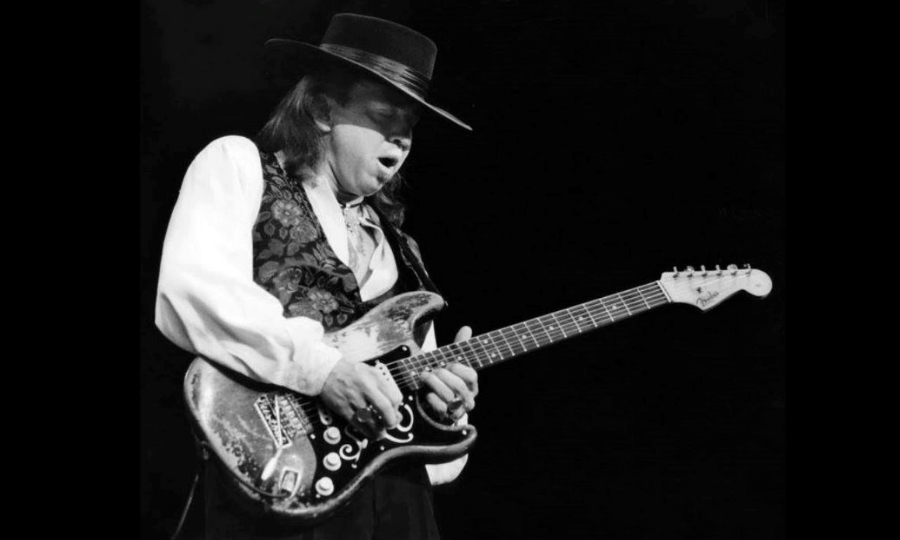When Jimi Hendrix left this world he left a smoking crater in his wake that has yet to be filled. The rock world has reeled from the blow ever since and while there have been many torch holders since they are but a candle to the flame of Hendrix’s might passion and soul. While many remember Jimi for his blistering lead breaks and showmanship it’s the quiet moments where we get a rare glimpse of the man behind the myth, and his most enduring work proves this: Little Wing.
Jimi Hendrix’s influence on Stevie Ray Vaughan is instantly tangible and integral to shaping the young Texan’s style as he would later be hailed the saviour of blues music. It was as if the duo were talking from beyond the grave and a part of Hendrix still shone in the sheer inventiveness and virtuosity of SRV.
To this day there is no piece of rock music that can match the singular, emotive power and intricate of instrumentation of Little Wing. 
From Jimi Hendrix to Eric Clapton to Stevie Ray Vaughan. This is the tale of how Little Wing moved three of the greatest guitarists of all time.
The Wings of Hendrix
During the three years and 362 days living in London, Jimi Hendrix – with a bottomless genius and immaculate sense of sound – conjured the most exquisite guitar music ever recorded, of that there is little argument. Whether confounded, elated, irate, or elevated one reaction shared amongst all who say Hendrix play was jaw-drop amazement.
For a song written in three minutes, there is an astonishing amount of depth. The guitar tone is so clean that you will wonder if he is even human as he established an evolving melancholic yet hopeful tone. Unlike many rock songs, the exquisite guitar playing never follows the same pattern. Even as the chords repeat, Hendrix employs his now-famed double stop technique to lend them different voicing and flair. Thus the story arc eludes expectation packing a remarkable amount of depth into its 2:27 duration.
“It’s just this gorgeous song that, as a guitar player, you can study your whole life and not get down, never get inside it the way that he does,” said Tom Morello in this 2011 tribute to Hendrix in Rolling Stone. “He seamlessly weaves chords and single-note runs together and uses chord voicings that don’t appear in any music books.”
Hendrix later revealed that the song was inspired by Monterey Pop Festival before he burnt his guitar and became world-famous.
In an interview, Jimi revealed it was “based on a very, very simple Indian style” and got the idea, “when we were in Monterey and I was just looking at everything around. So I figured that I take everything I see around and put it maybe in the form of a girl maybe, somethin’ like that, you know, and call it ‘Little Wing’, and then it will just fly away.”
Eric Clapton Soars
In the wake of Jimi’s passing, Eric Clapton was deeply scarred. A close friend and musical rival, Clapton was aspiring to apotheosis in the underground London clubs of the 1960s. ‘CLAPTON IS GOD’ proclaimed graffiti in the throes of the rock revolution. That was until Hendrix arrived at the ‘Square Mile’ and blew the game wide open.
In a later interview, Clapton is still visibly broken from the loss of his friend as he explains, “After Jimi dies I was incredibly angry cause I thought it was, not selfish on his part, but just a very lonely feeling to be left alone. After that, I kept running into people who were shoving him down my throat saying ‘Have you heard this one it’s never been on record before.’ To have these young kids playing guitar coming up and saying ‘I can do all this’, I’d say forget it mate it’s been done.”
The pain is practically bleeding from his eyes, “The night that he died I was supposed to meet him at the Lyceum to see Sly Stone play. I brought with me a left-handed Stratocaster, I just found it… he was in a box over there and I was in a box over here. I could see him but we never got together and the next day, whack he was gone and I was left with this left-handed Stratocaster.”
Two months after Jimi’s departure, Eric Clapton with Derek and the Dominos a resplendent, yet emotionally shattering rendition of Little Wing as a tribute to his late friend giving the poignantly simple lyric ‘Fly on, little wing’ an eerie new layer of meaning.
The definitive version of which was recorded live at the Fillmore East, in New York, proving Clapton was his only true contemporary rival.
Stevie Ray Vaughan
The definitive version of Little Wing would not arrive until 21 years later with Stevie Ray Vaughan’s posthumous fifth album The Sky Is Crying. The major difference is Vaughan, despite being a more than competent blues singer, left the vocals aside and focus solely on the prowess of his playing extending the track to 7 minutes.
Before Stevie Ray Vaughan was untimely taken from the world in a helicopter crash – one of the many Southern rock guitarists who died in transit – he recorded Little Wing in 1984, making it his own while paying tribute to his primary inspiration.
With minimal production and his famed Double Trouble trio in support, Stevie Ray gets deep inside the song sitting comfortably grounded within its movement. Whereas Clapton’s guitar soars ever higher, grasping for more, SRV is competently coaxing all of the possible emotion out of six strings. Halfway through the jam Stevie devolves into a diminutive selection of octave, quietly strumming along before exploding into a cacophony of sound, the guitar squealing and snarling, before locking back into the irresistible groove where his tone rings with the richness of crushed velvet and the clarity of crystal. Look no further for a masterpiece of pathos and skill. It’s all here, the pride and the joy, the pain and the devastation, the Texas flood.
The cover would earn Vaughan his sixth Grammy, for Best Rock Instrumental Performance, in 1992. The posthumous award would once again tie the song to death yet irrefutable joy. While both Clapton and Stevie Ray Vaughan’s versions appear outwardly better than the original, no one could get quite inside the song like Jimi.
Just as Hallelujah is to vocalists or Blowin’ In The Wind is to poets, all the best songs must be open to reinvention and offer the tantalising promise of release. Thus Little Wing shall not perish and remains Jim Hendrix’s most humble, yet undying creation.
While you’re here, check out:
- All Along The Watchtower: From Dylan to Hendrix
- Hurt: From Reznor to Cash
- Mad World: from Tears for Fears to Gary Jules
- Blue Suede Shoes: from Perkins to Presley
- Knockin’ On Heaven’s Door: From Dylan to Guns N’ Roses



